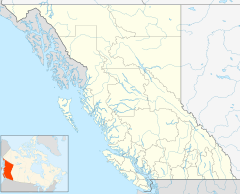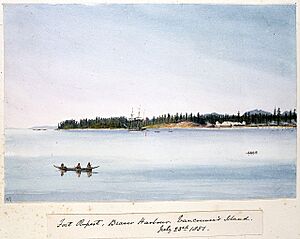Fort Rupert facts for kids
Quick facts for kids
Fort Rupert
|
|
|---|---|

Fort Rupert in 1878
|
|
| Country | |
| Province | BC/BCE |
| Region | Vancouver Island |
| Regional District | Mount Waddington |
| Area codes | 250, 778, 236, & 672 |
Fort Rupert was once an important trading post for the Hudson's Bay Company (HBC). It is located on the east coast near the northern tip of Vancouver Island, British Columbia. The small community on Beaver Harbour is about 11 kilometers (7 miles) southeast of Port Hardy.
| Top - 0-9 A B C D E F G H I J K L M N O P Q R S T U V W X Y Z |
Building Fort Rupert: A Trading Post
The Hudson's Bay Company found coal here in 1835. They hoped to sell it when more steamboats started using coal for fuel. The HBC realized they needed a new trading post after closing Fort McLoughlin. They also knew the British Navy was interested in getting coal from the area.
In 1849, Captain William Henry McNeill and John Work led a team to build Fort Rupert. It was named after Prince Rupert of the Rhine, who was the first governor of the Hudson's Bay Company. The fort was built with strong walls to protect it from local groups like the Nahwitti.
Fort Defenses and Life Inside
The fort had an 18-foot (5.5-meter) high stockade (a fence of strong posts). It also had two bastions, which are towers that stick out from the walls, where cannons could be placed. The fort was shaped like a square, with sides about 200 feet (61 meters) long. About a dozen European workers lived and worked inside the fort. The only way they connected with the outside world was when an HBC steamboat visited twice a year.
By 1851, the fort was fully built. That year, Robert Dunsmuir became the foreman for a group of coal miners who had moved there. Many of these Scottish miners did not want to do other jobs besides mining. They were also worried because the company offered little protection from attacks outside the fort. Workers who refused to do their jobs were sometimes put in chains and given less food. If workers tried to run away, they risked danger from the Nahwitti people. Because of these problems, coal mining stopped in 1852. Robert Dunsmuir then moved to work at the HBC coal operations in Nanaimo.
The cannons at Fort Rupert were not always ready to fire. This was because defending the fort against a very large attack would have been impossible. Sometimes, Nahwitti individuals would climb the outside walls and look down at the people inside.
First Nations Communities and History
Before the fort was built, there were no large First Nations settlements right next to it. But once the new trading post opened, a Kwakwaka'wakw community quickly grew nearby. This settlement became home to about 600–700 people. British Navy officers sometimes visited to help stop fighting between different First Nations groups.
During the 1862 Pacific Northwest smallpox epidemic, many Indigenous people were asked to leave their camps near Victoria. They had to return to their home territories. This unfortunately caused smallpox to spread across the Pacific Northwest coast. Groups of Kwakwakaʼwakw people brought smallpox from Victoria to the Fort Rupert area. A Hudson's Bay Company employee named Hamilton Moffat gave smallpox vaccines to over 100 tribal members near Fort Rupert. However, the disease still spread throughout northern Vancouver Island. Over the summer of 1862, the smallpox epidemic greatly reduced the Kwakwakaʼwakw population.
From Fort to General Store
Fort Rupert continued to operate as a trading post, but its business started to slow down in the 1860s. In 1863, a fire destroyed four houses and caused one death. In 1868, the fort's manager, Robert Hunt, was moved to Fort Simpson. He returned to Fort Rupert in 1872. By 1882, the Hudson's Bay Company had left the fort. In 1885, Robert Hunt bought the entire site for $1,500. A fire in 1889 destroyed the building where the officers used to live.
As the fort fell apart, the nearby Nahwitti people took items from the ruins. These included metal objects like knives, nails, and hammers. It is said that they also took iron and brass cannons and kept them in their village, Ku-Kultz.
The Hunt family opened a general store at the site. This store was later passed down to their descendants, the Cadwallader family. A record from 1890 mentions a theft of $96.50. Cadwallader found the two suspects, and the stolen money was returned.
Fort Rupert Today: A Kwakwaka'wakw Village
The modern-day village of Fort Rupert is a historic Kwakwaka'wakw village. It is home to the Kwagu'ł (also known as Kwagyewlth or Kwakiutl) and the Komoyue subgroup. Here, you can see people carving totem poles and creating traditional artwork and crafts. The band government for the Kwagu'ł people is the Kwakiutl First Nation.
You can also find Petroglyphs (ancient rock carvings) on the sandstone formations. These are in the higher tidal zones below where the old fort used to be, but they can be difficult to spot.
Archaeological Discoveries
It seems that a cannon from Ku-Kultz was taken to Vancouver in 1976. The Maritime Museum of British Columbia has a cast iron 9-pounder carronade (a type of short cannon) that they believe came from the fort. Later, scuba divers found six more cannons on a sandy beach in an isolated bay in the area.
At the original Fort Rupert site today, all that remains are some building foundations, drains, the large stone chimney from the manager's house, the Hunt family cemetery, and the collapsed Cadwallader store.





